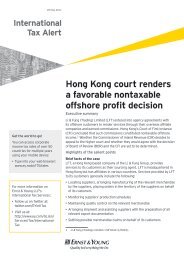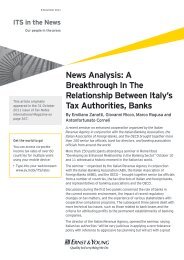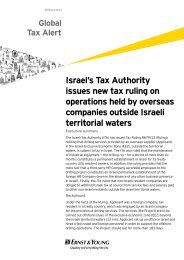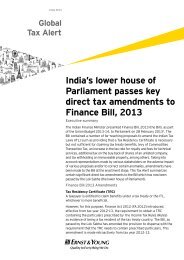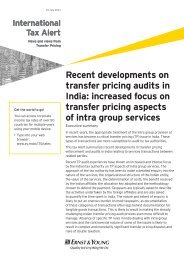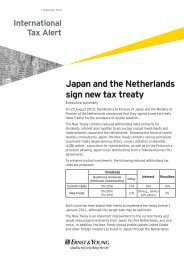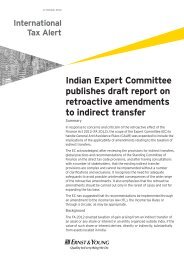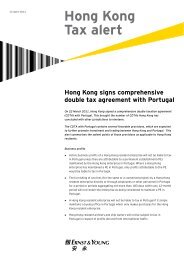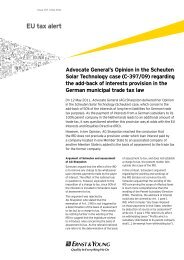Download - Ernst & Young T Magazine
Download - Ernst & Young T Magazine
Download - Ernst & Young T Magazine
You also want an ePaper? Increase the reach of your titles
YUMPU automatically turns print PDFs into web optimized ePapers that Google loves.
Feature The global executive<br />
80%<br />
The number of international<br />
transfers originating from<br />
China will increase by 80%<br />
between 2010 and 2014,<br />
according to <strong>Ernst</strong> & <strong>Young</strong>.<br />
Main drivers for sending<br />
people across borders<br />
86%<br />
Project-based<br />
84%<br />
Managerial and strategic<br />
75%<br />
Developmental<br />
50%<br />
Other<br />
32%<br />
Employee-driven<br />
Most common reason<br />
Least common reason<br />
14%<br />
16%<br />
25%<br />
50%<br />
68%<br />
Source: <strong>Ernst</strong> & <strong>Young</strong>’s Global Mobility<br />
Effectiveness Survey 2011<br />
generation, so they will become more global.”<br />
<strong>Ernst</strong> & <strong>Young</strong>’s research backs this up:<br />
companies expect to increase the number of<br />
international transfers originating from China by<br />
80% between 2010 and 2014, and those from<br />
Russia and Africa by 67%. India will see less<br />
growth (13%), but from a far higher baseline,<br />
given it has an average of three times as many<br />
outbound assignees as incoming ones.<br />
This highly visible change reflects an even<br />
more fundamental one: if the expat executive<br />
model seems still to be thriving, it is because its<br />
very purpose has adapted to a more globalized<br />
business environment. “The idea of people being<br />
sent out from head office to colonize the world<br />
ended more than 10 years ago,” says Peter<br />
Ferrigno, the EMEIA Area Leader for Human<br />
Capital at <strong>Ernst</strong> & <strong>Young</strong>. This reflects the way in<br />
which many companies have moved away from a<br />
model in which a central head office, frequently<br />
with distinct characteristics shaped by the<br />
business’s country of origin, controlled what<br />
were essentially branch operations abroad.<br />
Instead, leading firms today are seeking to create<br />
more integrated, global operations.<br />
Inevitably, this has affected the role of the<br />
global executive. At a broad level, executives<br />
going abroad no longer resemble high-ranking<br />
foreign dignitaries from the corporate center, but<br />
are increasingly arriving to work as equals with<br />
others. In line with this, the primary objectives in<br />
sending them have grown more complex. The<br />
main ones now include:<br />
Filling vacancies/project support<br />
This objective has always been an important<br />
driver of international transfers and remains the<br />
most common reason for sending employees<br />
across borders. Globalization and modern<br />
technology, however, allow a greater use of<br />
international talent in this way and new forms of<br />
assignment for global executives. Indeed, Waty<br />
notes an increasingly common phenomenon,<br />
especially within Europe, of business travelers<br />
who spend weekdays in one country and return<br />
to their homes in another country for the<br />
weekend. Others companies are embracing<br />
“virtual” international assignments, notes Steele,<br />
with executives working as part of teams in<br />
another country while remaining in their own<br />
home countries. “It is not ideal but, with<br />
technology, it is increasingly feasible and<br />
increasingly being done,” she says. This also<br />
avoids many of the practical difficulties and costs<br />
of sending people to another country.<br />
Knowledge transfer<br />
The benefits of bringing knowledge from one<br />
part of the company to another have also always<br />
been a driver in the use of international<br />
executives, but the direction of flow is no longer<br />
one-way. For example, Indian and Chinese<br />
executives often have more experience with the<br />
intricacies of outsourcing, says Waty. They can<br />
bring such expertise along on placements in<br />
Europe or North America. Greg Schupp, Partner<br />
for Human Capital at <strong>Ernst</strong> & <strong>Young</strong> in the United<br />
States, sees this cross-fertilization as an<br />
important benefit of modern expatriate postings.<br />
“The more diverse and inclusive your teams can<br />
be, the more global and thought-provoking they<br />
become. The solutions they propose tend to be<br />
better for the organization.”<br />
Developing executives<br />
International transfers have also always been<br />
used for executive development, and as a benefit<br />
to retain talent. But in global companies, the<br />
scope of these opportunities has changed. These<br />
sorts of assignments – especially short-term<br />
ones – are happening earlier in careers, notes<br />
Steele. Her own company has found that, in<br />
emerging markets, taking new local hires and<br />
giving them international exposure is a fast and<br />
efficient way of growing talent. <strong>Ernst</strong> & <strong>Young</strong>’s<br />
Global Mobility Effectiveness Survey indicates<br />
that this practice is common in emerging<br />
markets with, for example, junior executives<br />
making up half of outbound assignees from India<br />
– in part to make up for the lack of experienced<br />
senior executives to provide mentorship. “If you<br />
find decent people in a small country, sometimes<br />
they outgrow the local market,” says Ferrigno.<br />
“You need to take people like that into the global<br />
talent pool.”<br />
Creating the company’s future leaders<br />
International exposure is becoming ever more<br />
important for businesses seeking to train<br />
leadership prospects. The reason is simple. “If<br />
only 5% of your business is in the home country,<br />
and you’ve only worked there, how qualified are<br />
you to sit on the board?” asks Ferrigno. Novartis<br />
has institutionalized this in its leadership<br />
development processes. Once a year, its<br />
executive committee looks at people who have<br />
the potential to become future leaders of the<br />
company and then considers how international<br />
postings should figure in their development. “We<br />
are 150 countries,” explains Waty. “A successful<br />
global executive is someone who can hit the<br />
ground running, can pick up the nuances of the<br />
new location quickly, can spot the issues quickly<br />
and begin delivering on the issues in a very short<br />
space of time. They should also be able to bring<br />
an insight into how other markets operate and<br />
other ways of doing things.”<br />
Getting the most out of international<br />
assignments<br />
If these goals are met, sending executives across<br />
borders can create substantial value for<br />
companies, but at a cost. Although dependent on<br />
the location and position, Schupp estimates that<br />
the total expense may be as high as three to five<br />
times that of the base salary of an executive who<br />
stays at home. “The cost is such that you have to<br />
make sure there will be a benefit,” adds Steele.<br />
10 T <strong>Magazine</strong> Issue 07 <strong>Ernst</strong> & <strong>Young</strong>



